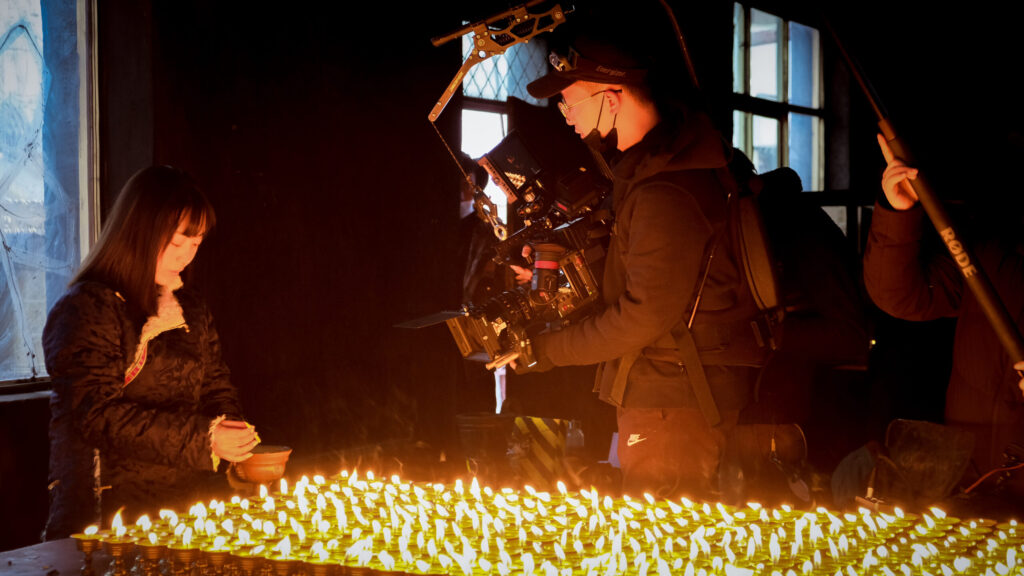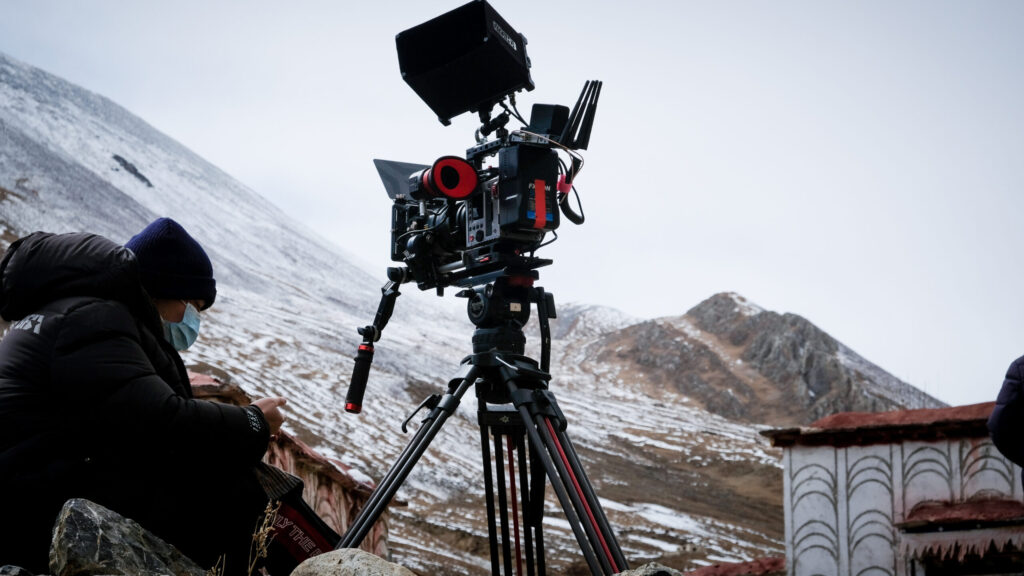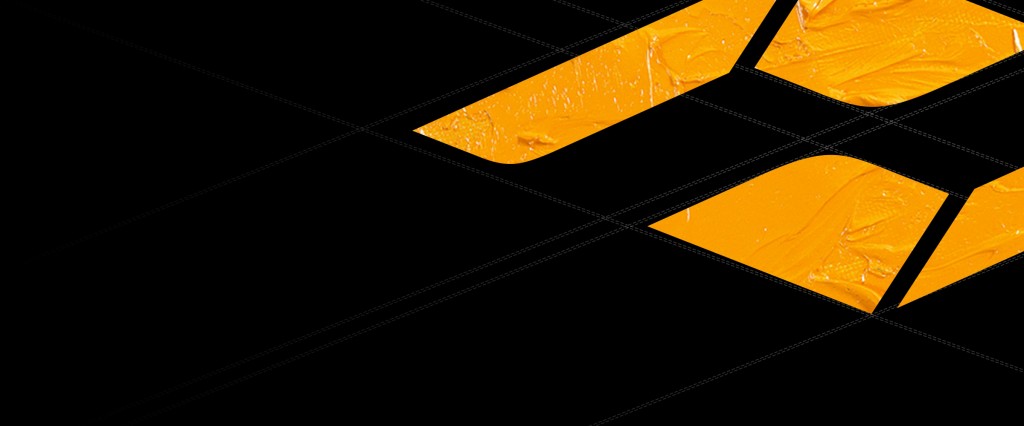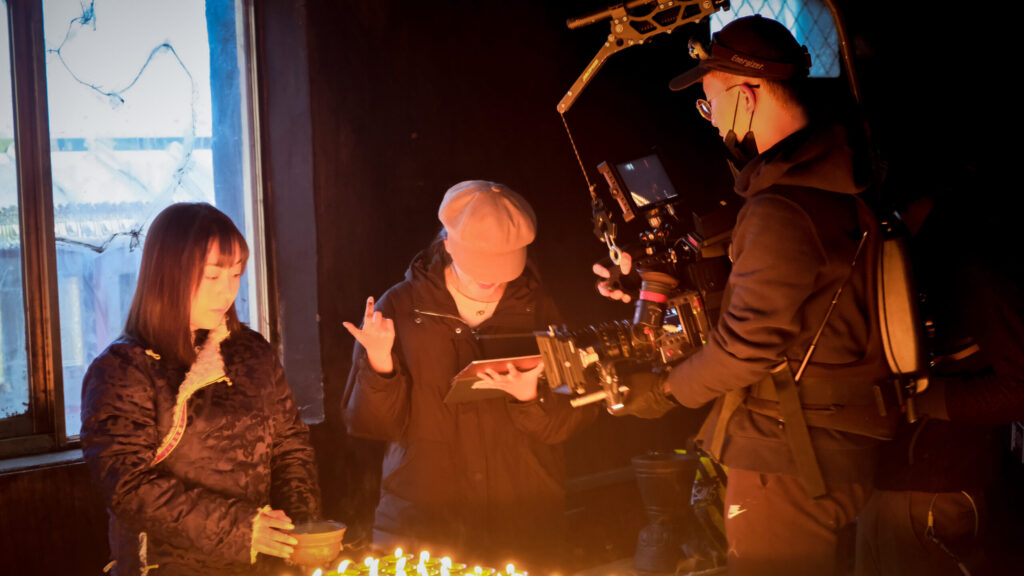No products in the cart.
Filming Cases, Others
TINNITUS

The shooting site of Tinnitus crew
“The Tibetan plateau has strong sunlight and variable cloud cover. So the overall control of the exposure process, I was much benefited from the MAVO Edge 6K three design: built-in ND, dual native ISO, and highlight stops. These three designs give me efficiency and flexibility in exposure that no other camera has been able to give me.”
DP Li Siwei of the film TINNITUS
Grandmother died, but Jade was unable to go to the temple to burn the lamp for her due to altitude sickness. On her way in the dream world, she meets her grandmother and herself in another possibility …… When she wakes up from her dream, Jade feels confused and the events in her real life are wonderfully connected to her dream ……
Tinnitus is a 20-minute Tibetan-language short film directed by Tsering Yangjin, a graduate student at the Baptist University Film School. And the DP, Li Siwei, is a cinematographer from Chengdu, Sichuan province. He graduated from the American Film Institute with a master’s degree in cinematography, and his work has won awards such as Best Cinematography at the Berlin Independent Film Festival and Cinegear Film Series.
In order to let you feel the impact of the Edge 6K’s fully integrated compact body and new technology on the film in more detail, we invited the DP of Tinnitus, Li Siwei, to share his experience with us.

Li Siwei is shooting with MAVO Edge 6K
Kine Team At the beginning of the shooting of Tinnitus, did you have any design for the shooting plan or shooting method? Why you choose the MAVO Edge 6K camera?
Li Siwei For me, Tinnitus is a work with a sincere emotional core and a high degree of artistry in its emotional expression. The story has both a clear subjective perspective and a certain proportion of abstract text-based passages. For this reason, we have chosen a visual language that combines handheld and fixed shots in the design of the camera style, using a coherent handheld shooting to close the inner emotions of the protagonist Jade, and using the fixed shooting to convey the objectivity of the text.
I have used the Mavo LF and Mavo Edge 8K before. And the ease of use, shooting efficiency and color science of them have bringed good experiences to me. This time the high altitude of shooting conditions demanded a camera that was lightweight and stable, and the Mavo Edge 6K was designed to meet these challenges well, so I chose it.

MAVO Edge 6K shooting at high altitude area
Li Siwei And it turns out that choosing MAVO Edge 6K for this shoot was a good decision for us. The shooting style of Tinnitus was non-industrial, with more chance for improvisation and free play. So most of the shots were handheld. Addtionally, the scenes we shot are in Lhasa at an altitude of 3600 meters, some mountain locations reached more than 4000 meters. All of these cause me a little tired after the whole shooting, but if we replaced Edge 6K to some other mainstream cameras, the whole shooting will be much harder. The compact and lightweight body design of Edge 6K significantly reduced the burden of shooting for myself and the entire camera team.
Kine Team What was your impression of the MAVO Edge 6K during the week that this film lasted?
Li Siwei I’ve always liked the design philosophy of Kinefinity. Recent generations of Kinefinity cameras have had a more square design, with a minimalist style of button settings and menus.
When I unboxed the MAVO Edge 6K, I was surprised by the appearance of the camera. The deep gray appearance is beautiful, the body is small and lightweight, but the workmanship of the camera feels solid and reliable. I was familiar with the logic of the menu and the features of the machine, and this time the camera with the touch screen monitor is more intuitive and convenient in actual operation.
I think the MAVO Edge 6K is the best Kinefinity camera I’ve used in years, especially in terms of image quality. Before the film shooting started, I shot 6K and 4K footage as a test comparison, and the image quality was excellent. I was hoping to use 6K resolution for this shoot, but considering the size of the footage and the burden of the post-production process, we chose to shoot FF 4K HD ProRes 4444 finally. But the 4K image quality from the full-frame 6K super capture was perfectly suited for our needs.

the appearance of MAVO Edge 6K
Kine Team Were there any difficulties or challenges on the process of this film? How did you overcome them?
Li Siwei This film shoot was quite challenging. The plateau sunlight was strong and the clouds were variable, and we were limited by the conditions. So in terms of lighting, we wanted to use, rather than fight against the strong sunlight. The overall control of the exposure process, I was much benefited from the MAVO Edge 6K three design: built-in ND, dual native ISO, and highlight stops. These three designs give me efficiency and flexibility in exposure that no other camera has been able to give me.
Even though we shot in the daytime, the time of I used ISO 5120 still reach 30-40%. Because sometimes our schedule is tight, I need this exposure to shoot some relatively tight images at early morning and late evening. And I was impressed with the performance of the MAVO Edge 6k at ISO 5120, which is one of the cleanest high-sensitivity images I’ve ever seen. Due to the test I did after I got the camera, I could switch back and forth between ISO 5120 and ISO 800 for the entire shoot, and it met our needs for exposure and for latitude very well. I think in comparison with other machines, the MAVO Edge 6K has done its own irreplaceable existence in terms of high sensitivity.

MAVO Edge 6K shooting in Tibet
Li Siwei The film shoot also encountered the challenge of durability. We had a scene shot in a room full with a thousand burning ghee lamps, where temperature may have exceeded 30 or even 40 degrees without opening windows and doors. This was the part I was worried about at first, because afterwards we needed to switch to a purely outdoor environment and the temperature would be below zero again. We made some precautions for the switch from very cold to very hot conditions forcamera, such as putting a baby warmer in the down jacket to give the camera body a temperature transition. And the complete shoot proceed shows whether in high temperature conditions or high altitude low temperature environment, the machine performance is very very stable.

Screenshot of Tinnitus burning ghee lamps room clip
Kine Team How about the preformance of the clips?
Li Siwei Tinnitus is in the process of editing, and I have currently saw some of the clips. As I tested at the beginning, I am quite satisfied with the image quality and latitude. This time the image was very rich in highlight detail and the majority of the time I used the highlight stop 6.0 and above. So there are some places that I thought would be overexposed when shooting, but thanks to the camera’s excellent latitude, there is still some detail in the highlights after post-processing. The performance of the clips in post made me feel that Kinefinity’s CMOS for the MAVO Edge 6K is a very excellent tuning.

The shooting site of Tinnitus crew
Kine Team What do you think of the color science of MAVO Edge 6K?
Li Siwei I think it’s great. I’m describing the color of the Kinefinity camera more from an intuitive point of view, because I haven’t done very rigorous skin tone comparisons or anything like that. When I was shooting in LA, I had a collection of Log C color files from the color mixing company. And when I use the Kinefinity camera for the next project, in many cases, I will directly use it for monitoring. Because Kinefinity’s KineLOG3 is close to the Log C for me, I was particularly pleased with the color of the Kinefinity camera in general.
The colorist and I are also making some attempts to the Tinnitus, and there are already some results that we are both satisfied with. The Kinefinity color science is very excellent for me throughout the whole post-production process.

Still frame of the original Tinnitus footage
Kine Team Finally, please describe briefly your overall impressions of the MAVO Edge 6K.
Li Siwei For independent filmmaking, I’m lucky to be able to use a camera like MAVO Edge 6K. I’ve told many friends that this is the best Kinefinity camera I’ve ever used.
I think the innovations in many features, like the highlight stops, have greatly helped matographers in their work. In film school we’re used to shooting in a industrial and rigorous way, with the same light holes, the same format, etc., but in the real world situations actually you need to get the best shot with maximum efficiency.
And the Kinefinity camera has many features that greatly expand the efficiency of independent productions, bringing more possibilities to photographers in an uncompromising and innovative way, and saving us a lot of time, especially in the area of exposure. I think the built-in e-ND and the dual native ISO, plus the design of the highlight stops of MAVO Edge 6K is really excellent!
Thanks for DP Li Siwei ! This is the end of the interview. I hope it will be helpful to those interested in Kinefinity.


